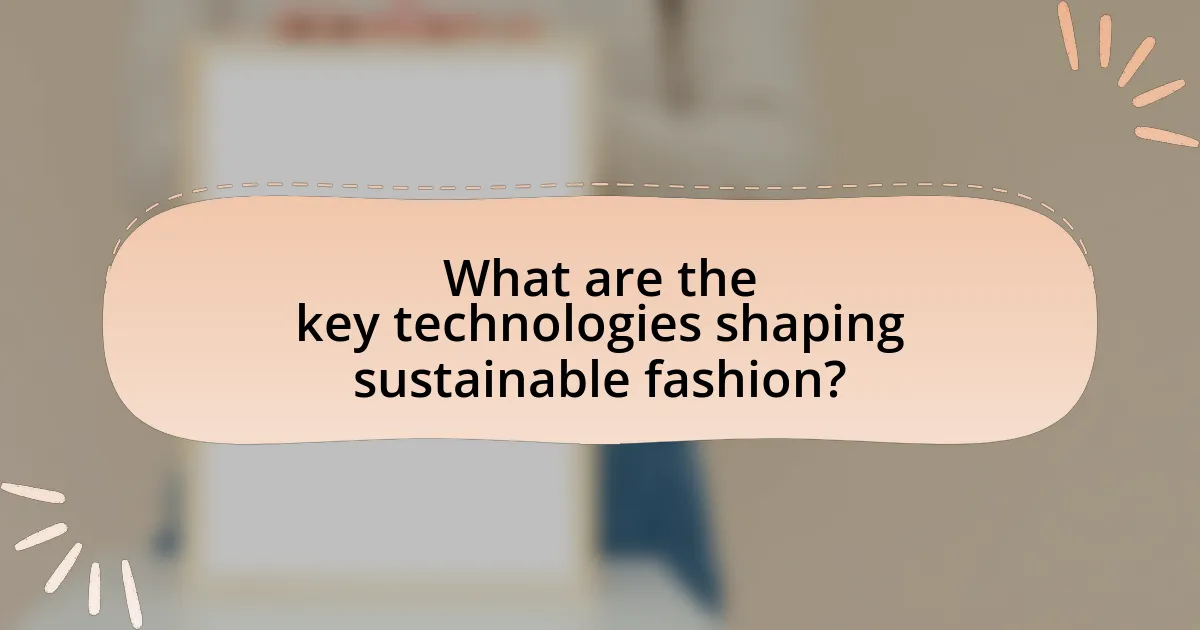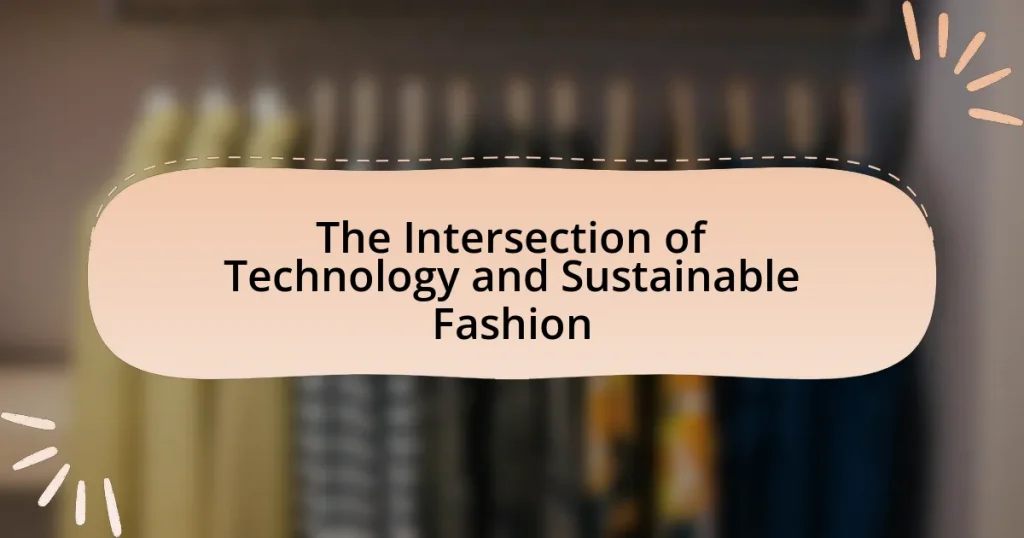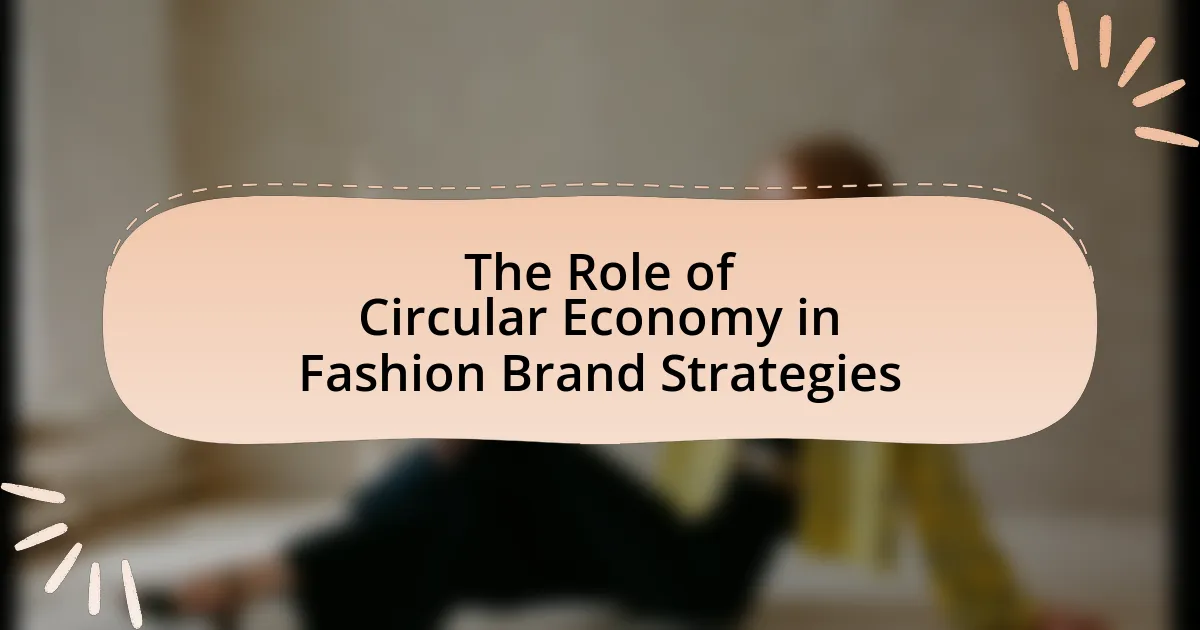The article explores the intersection of technology and sustainable fashion, highlighting how innovative technologies such as artificial intelligence, blockchain, and 3D printing are transforming the fashion industry towards greater environmental sustainability. It discusses the relationship between technology and sustainable practices, including advancements in textile recycling, supply chain optimization, and the development of eco-friendly materials. Key technologies shaping sustainable fashion are examined, along with their benefits in reducing waste, enhancing resource efficiency, and promoting transparency. The article also addresses the challenges brands face in integrating technology and offers practical tips for consumers to identify and support sustainable fashion initiatives.

What is the Intersection of Technology and Sustainable Fashion?
The intersection of technology and sustainable fashion involves the integration of innovative technologies to enhance environmental sustainability in the fashion industry. Technologies such as artificial intelligence, blockchain, and 3D printing are being utilized to optimize supply chains, reduce waste, and promote ethical sourcing. For instance, AI can analyze consumer data to predict trends, minimizing overproduction, while blockchain ensures transparency in sourcing materials, allowing consumers to verify the sustainability of their purchases. According to a report by McKinsey & Company, the adoption of these technologies can significantly reduce the fashion industry’s carbon footprint, aligning with global sustainability goals.
How do technology and sustainable fashion relate to each other?
Technology and sustainable fashion are interconnected through innovations that enhance eco-friendly practices in the fashion industry. For instance, advancements in textile recycling technologies allow for the transformation of waste materials into new fabrics, significantly reducing environmental impact. According to a report by the Ellen MacArthur Foundation, implementing circular economy principles in fashion could reduce greenhouse gas emissions by 44% by 2030. Additionally, digital tools such as 3D modeling and virtual fitting rooms minimize waste by optimizing production processes and reducing returns. These technological advancements not only promote sustainability but also drive efficiency and transparency in the fashion supply chain.
What technological advancements are influencing sustainable fashion?
Technological advancements influencing sustainable fashion include innovations in materials, production processes, and supply chain management. For instance, the development of biodegradable fabrics, such as those made from organic cotton or recycled polyester, reduces environmental impact by minimizing waste. Additionally, 3D printing technology allows for on-demand production, which decreases overproduction and waste in the fashion industry. Furthermore, blockchain technology enhances transparency in supply chains, enabling consumers to verify the sustainability of their purchases. According to a report by McKinsey & Company, these technologies can significantly reduce the carbon footprint of the fashion industry, which is responsible for approximately 10% of global greenhouse gas emissions.
How does sustainable fashion benefit from technological innovations?
Sustainable fashion benefits from technological innovations by enhancing resource efficiency and reducing waste throughout the production process. Technologies such as 3D printing and digital textile printing allow for precise manufacturing, minimizing excess materials and energy consumption. For instance, a study by the Ellen MacArthur Foundation highlights that 3D printing can reduce material waste by up to 90% compared to traditional methods. Additionally, advancements in fabric recycling technologies enable the recovery of materials from discarded garments, further promoting a circular economy. These innovations not only lower the environmental impact of fashion but also drive economic benefits by optimizing supply chains and reducing costs associated with waste management.
Why is the intersection of technology and sustainable fashion important?
The intersection of technology and sustainable fashion is important because it enables innovative solutions that reduce environmental impact and enhance resource efficiency. Technology facilitates the development of sustainable materials, such as bio-fabricated textiles and recycled fibers, which significantly lower carbon emissions and waste associated with traditional fashion production. For instance, a study by the Ellen MacArthur Foundation highlights that adopting circular economy principles in fashion could reduce global greenhouse gas emissions by 44% by 2030. Additionally, advancements in supply chain transparency through blockchain technology allow consumers to make informed choices, promoting ethical practices in the industry. This integration of technology not only supports sustainability goals but also drives economic growth by creating new markets and job opportunities in the green economy.
What environmental challenges does sustainable fashion address?
Sustainable fashion addresses several environmental challenges, including excessive waste, resource depletion, and pollution. The fashion industry is responsible for approximately 92 million tons of waste annually, much of which ends up in landfills. Additionally, it consumes vast amounts of water, with the production of a single cotton t-shirt requiring around 2,700 liters of water. Sustainable fashion aims to reduce these impacts by promoting practices such as recycling, using eco-friendly materials, and implementing ethical production methods. These approaches help mitigate the negative effects of traditional fashion on the environment, contributing to a more sustainable future.
How can technology help mitigate these challenges?
Technology can help mitigate challenges in sustainable fashion by enabling efficient resource management and reducing waste. For instance, advanced data analytics can optimize supply chains, leading to reduced overproduction and minimizing excess inventory. According to a report by McKinsey & Company, implementing digital tools in supply chain management can decrease waste by up to 30%. Additionally, innovations such as 3D printing allow for on-demand production, which further reduces material waste and energy consumption. Furthermore, blockchain technology enhances transparency in sourcing, ensuring ethical practices and fostering consumer trust. This combination of technologies not only addresses environmental concerns but also promotes sustainable practices within the fashion industry.

What are the key technologies shaping sustainable fashion?
Key technologies shaping sustainable fashion include digital textile printing, blockchain, and sustainable materials innovation. Digital textile printing reduces waste by allowing for on-demand production, minimizing excess inventory and resource use. Blockchain technology enhances transparency in supply chains, enabling consumers to verify the sustainability of products and practices. Sustainable materials innovation, such as bio-based fabrics and recycled textiles, significantly lowers the environmental impact of garment production. For instance, the use of recycled polyester can reduce energy consumption by up to 60% compared to virgin polyester production. These technologies collectively contribute to a more sustainable fashion industry by promoting efficiency, transparency, and eco-friendly practices.
How is artificial intelligence used in sustainable fashion?
Artificial intelligence is used in sustainable fashion primarily to optimize supply chains and reduce waste. By analyzing data on consumer preferences and production processes, AI can predict demand more accurately, allowing brands to produce only what is needed. This minimizes overproduction, a significant issue in the fashion industry, where it is estimated that 92 million tons of textile waste are generated annually. Additionally, AI technologies, such as machine learning algorithms, can enhance material sourcing by identifying sustainable fabrics and suppliers, further promoting eco-friendly practices.
What role does AI play in supply chain optimization?
AI plays a crucial role in supply chain optimization by enhancing efficiency, reducing costs, and improving decision-making processes. Through predictive analytics, AI analyzes vast amounts of data to forecast demand accurately, enabling companies to optimize inventory levels and reduce waste. For instance, a study by McKinsey & Company found that companies using AI in their supply chains can reduce forecasting errors by 50%, leading to significant cost savings and improved service levels. Additionally, AI-driven automation streamlines logistics and enhances visibility across the supply chain, allowing for real-time tracking and better resource allocation. This integration of AI not only boosts operational efficiency but also supports sustainable practices by minimizing excess production and resource consumption.
How can AI enhance consumer personalization in sustainable fashion?
AI can enhance consumer personalization in sustainable fashion by analyzing consumer data to provide tailored recommendations and experiences. By leveraging machine learning algorithms, AI can assess individual preferences, purchase history, and browsing behavior to suggest sustainable products that align with a consumer’s values and style. For instance, a study by McKinsey & Company found that personalized recommendations can increase sales by up to 10-30%, demonstrating the effectiveness of AI in driving consumer engagement. Additionally, AI can optimize inventory management by predicting trends and consumer demand, ensuring that sustainable fashion brands offer the right products at the right time, thus reducing waste and promoting eco-friendly practices.
What impact does 3D printing have on sustainable fashion?
3D printing significantly impacts sustainable fashion by enabling on-demand production, which reduces waste and overproduction. Traditional fashion manufacturing often leads to excess inventory and material waste, whereas 3D printing allows designers to create items only as needed, minimizing surplus. According to a study by the Ellen MacArthur Foundation, the fashion industry generates over 92 million tons of waste annually, and adopting 3D printing can help mitigate this issue by streamlining the supply chain and reducing the carbon footprint associated with transportation and storage. Additionally, 3D printing facilitates the use of sustainable materials, such as biodegradable plastics, further enhancing the eco-friendliness of fashion products.
How does 3D printing reduce waste in the fashion industry?
3D printing reduces waste in the fashion industry by enabling on-demand production, which minimizes excess inventory and material usage. Traditional manufacturing often results in significant waste due to overproduction and the cutting of fabric, whereas 3D printing allows designers to create items only as needed, thus aligning production closely with consumer demand. According to a study by the Ellen MacArthur Foundation, the fashion industry generates over 92 million tons of waste annually, much of which can be mitigated through technologies like 3D printing that promote efficient resource use and reduce the need for large-scale production runs.
What are the limitations of 3D printing in sustainable fashion?
The limitations of 3D printing in sustainable fashion include high energy consumption, material constraints, and scalability issues. High energy consumption arises from the processes involved in 3D printing, which can negate some sustainability benefits; for instance, certain printers require significant electricity to operate. Material constraints refer to the limited range of sustainable materials available for 3D printing, as many commonly used filaments are derived from non-renewable resources. Scalability issues occur because while 3D printing allows for customization and reduced waste, it is not yet capable of producing large quantities efficiently, which is essential for meeting mass market demands in the fashion industry.

How can brands effectively integrate technology into sustainable fashion practices?
Brands can effectively integrate technology into sustainable fashion practices by utilizing data analytics, blockchain, and innovative materials. Data analytics enables brands to optimize supply chains, reducing waste and improving resource efficiency; for instance, companies like Zara use data to forecast demand accurately, minimizing overproduction. Blockchain technology enhances transparency in sourcing and production, allowing consumers to trace the origins of materials, as demonstrated by brands like Everledger, which tracks diamonds and other materials to ensure ethical sourcing. Additionally, the development of innovative materials, such as bio-fabricated textiles and recycled fibers, supports sustainability by reducing reliance on virgin resources; for example, companies like Stella McCartney are pioneering the use of mycelium leather alternatives. These technological integrations not only promote sustainability but also align with consumer demand for ethical practices in the fashion industry.
What strategies can brands adopt to leverage technology for sustainability?
Brands can adopt strategies such as utilizing data analytics, implementing blockchain technology, and embracing circular economy principles to leverage technology for sustainability. Data analytics enables brands to optimize supply chains, reduce waste, and enhance resource efficiency by analyzing consumption patterns and predicting demand. Blockchain technology provides transparency in sourcing and production processes, allowing consumers to verify the sustainability claims of products, which can lead to increased trust and brand loyalty. Additionally, adopting circular economy principles through technology, such as using digital platforms for product take-back programs, can facilitate recycling and repurposing of materials, thereby minimizing environmental impact. These strategies are supported by research indicating that companies leveraging technology for sustainability can achieve significant reductions in carbon emissions and resource consumption, ultimately contributing to a more sustainable fashion industry.
How can brands use data analytics to improve sustainability efforts?
Brands can use data analytics to improve sustainability efforts by analyzing supply chain data to identify inefficiencies and reduce waste. For instance, data analytics can reveal patterns in resource consumption, enabling brands to optimize production processes and minimize excess materials. A study by McKinsey & Company found that companies leveraging data analytics in their supply chains can reduce costs by 15-20% while also decreasing their environmental impact. By utilizing predictive analytics, brands can forecast demand more accurately, leading to better inventory management and less overproduction, which is a significant contributor to waste in the fashion industry.
What are the best practices for implementing technology in sustainable fashion?
The best practices for implementing technology in sustainable fashion include utilizing digital tools for supply chain transparency, adopting sustainable materials through innovative textile technology, and leveraging data analytics for efficient resource management. Supply chain transparency can be enhanced by using blockchain technology, which allows brands to track the origin and journey of materials, ensuring ethical sourcing. Innovative textile technologies, such as bio-fabrication and recycling processes, enable the creation of sustainable materials that reduce environmental impact. Data analytics helps brands optimize production processes, minimize waste, and forecast demand accurately, leading to more sustainable practices. These approaches are supported by industry reports indicating that technology can significantly reduce the carbon footprint of fashion production and improve overall sustainability.
What challenges do brands face when merging technology with sustainable fashion?
Brands face significant challenges when merging technology with sustainable fashion, primarily due to high costs, technological integration issues, and consumer perception. High costs arise from the investment required for sustainable materials and advanced technologies, which can deter brands from adopting these practices. Technological integration issues include the difficulty of aligning new technologies with existing supply chains and production processes, often leading to inefficiencies. Additionally, consumer perception poses a challenge, as many consumers may not fully understand or trust the sustainability claims associated with technological innovations, impacting their purchasing decisions. These factors collectively hinder the effective merging of technology and sustainable fashion.
How can brands overcome resistance to technological change?
Brands can overcome resistance to technological change by fostering a culture of innovation and providing comprehensive training for employees. By actively engaging staff in the technological transition process, brands can alleviate fears and build confidence in new systems. Research indicates that companies that prioritize employee involvement in change initiatives experience a 70% success rate in implementation (Kotter, 1996). Additionally, transparent communication about the benefits of technology, such as improved efficiency and sustainability, can help align employee interests with organizational goals, further reducing resistance.
What are the financial implications of adopting new technologies?
Adopting new technologies in sustainable fashion can lead to significant financial implications, including both initial investment costs and long-term savings. The initial costs often involve purchasing advanced machinery, software, or training employees, which can be substantial; for instance, implementing automated production systems can require investments exceeding $100,000. However, these technologies can enhance efficiency, reduce waste, and lower operational costs over time. A study by McKinsey & Company found that companies utilizing digital technologies in their supply chains could reduce costs by up to 30%. Additionally, adopting sustainable technologies can improve brand reputation and attract eco-conscious consumers, potentially increasing sales and market share. Thus, while the upfront financial implications may be considerable, the long-term benefits can outweigh these costs, leading to overall financial gains.
What are practical tips for consumers interested in sustainable fashion technology?
Consumers interested in sustainable fashion technology should prioritize purchasing from brands that utilize eco-friendly materials and ethical production practices. Research indicates that brands using organic cotton, recycled polyester, and innovative materials like Tencel significantly reduce environmental impact compared to conventional fabrics. Additionally, consumers can support companies that implement transparent supply chains, allowing them to trace the origins of their clothing. Engaging with second-hand and upcycled fashion options also contributes to sustainability by extending the lifecycle of garments. According to a report by the Ellen MacArthur Foundation, extending the life of clothing by just nine months can reduce carbon, water, and waste footprints by around 20-30%. Lastly, consumers should consider investing in technology that enhances garment longevity, such as fabric care products that reduce wear and tear.
How can consumers identify sustainable fashion brands using technology?
Consumers can identify sustainable fashion brands using technology through various digital tools and platforms that assess and verify sustainability practices. Applications like Good On You provide ratings based on ethical practices, while blockchain technology offers transparency in supply chains, allowing consumers to trace the origins of materials and labor conditions. Additionally, online databases and websites, such as the Fashion Transparency Index, compile information on brands’ sustainability efforts, enabling informed purchasing decisions. These technological solutions empower consumers to make choices aligned with their values regarding environmental and social responsibility.
What role can consumers play in promoting technology-driven sustainable fashion?
Consumers play a crucial role in promoting technology-driven sustainable fashion by making informed purchasing decisions that prioritize eco-friendly brands and innovative materials. By choosing products made from sustainable resources and supporting companies that utilize technology for waste reduction and ethical production, consumers can drive demand for sustainable practices in the fashion industry. For instance, a report by McKinsey & Company highlights that 66% of global consumers are willing to pay more for sustainable brands, indicating a significant market shift towards eco-conscious consumerism. This consumer behavior encourages brands to invest in sustainable technologies, such as 3D printing and digital supply chain management, which can minimize environmental impact and enhance transparency.




